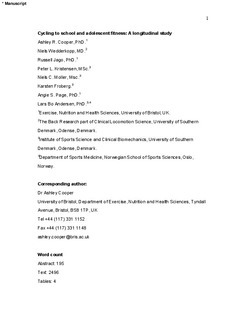| dc.contributor.author | Cooper, Ashley R. | |
| dc.contributor.author | Wedderkopp, Niels | |
| dc.contributor.author | Jago, Russell | |
| dc.contributor.author | Kristensen, Peter Lund | |
| dc.contributor.author | Møller, Niels C. | |
| dc.contributor.author | Froberg, Karsten | |
| dc.contributor.author | Page, Angie S. | |
| dc.contributor.author | Andersen, Lars Bo | |
| dc.date.accessioned | 2009-01-12T12:47:07Z | |
| dc.date.issued | 2008-06-18 | |
| dc.identifier | Seksjon for idrettsmedisinske fag / Department of Sports Medicine | |
| dc.identifier.citation | Preventive Medicine. 2008, 47(3), 324-328 | en |
| dc.identifier.issn | 0091-7435 | |
| dc.identifier.uri | http://hdl.handle.net/11250/170423 | |
| dc.description | I Brage finner du siste tekst-versjon av artikkelen, og den kan inneholde ubetydelige forskjeller fra forlagets pdf-versjon. Forlagets pdf-versjon finner du på www.sciencedirect.com: http://dx.doi.org/10.1016/j.ypmed.2008.06.009 / In Brage you'll find the final text version of the article, and it may contain insignificant differences from the journal's pdf version. The original publication is available at www.sciencedirect.com: http://dx.doi.org/10.1016/j.ypmed.2008.06.009 | en |
| dc.description.abstract | Objective: To investigate whether change in transport to school from non-cycling to cycling was associated with change in cardio-respiratory fitness (CRF) over a six-year follow-up.
Methods: Participants were 384 children (9.7 (0.5) years) who participated in the Danish arm of the European Youth Heart Study in 1997 and who were followed up 6 years later. CRF was assessed by a maximal cycle ergometer test and travel to school was investigated by questionnaire at both time points. Linear regression models were used to investigate associations between CRF and change in mode of travel to school between baseline and follow-up.
Results: Higher CRF was significantly associated with cycling to school in children and adolescents of both sexes. Longitudinal regression models showed that a change in travel mode from non-cycling to cycling was a significant predictor of CRF at follow-up (P < 0.001) after adjustment for potential confounders. Participants who did not cycle to school at baseline, but who had changed to cycling at follow-up, were significantly fitter (0.33 W kg− 1) than those who did not cycle to school at either time point (P = 0.001), a difference of 9%.
Conclusion: Cycling to school may contribute to higher cardiovascular fitness in young people. | en |
| dc.format.extent | 309627 bytes | |
| dc.format.mimetype | application/pdf | |
| dc.language.iso | eng | en |
| dc.publisher | Elsevier | en |
| dc.subject | youth | en |
| dc.subject | active commuting | en |
| dc.subject | health | en |
| dc.subject | transportation | en |
| dc.subject | cycling | en |
| dc.subject | fitness | en |
| dc.title | Longitudinal associations of cycling to school with adolescent fitness | en |
| dc.type | Peer reviewed | en |
| dc.type | Journal article | en |
| dc.subject.nsi | VDP::Medical disciplines:700 | |
| dc.source.pagenumber | 324-328 | en |
| dc.source.volume | 47 | en |
| dc.source.journal | Preventive Medicine | en |
| dc.source.issue | 3 | en |
